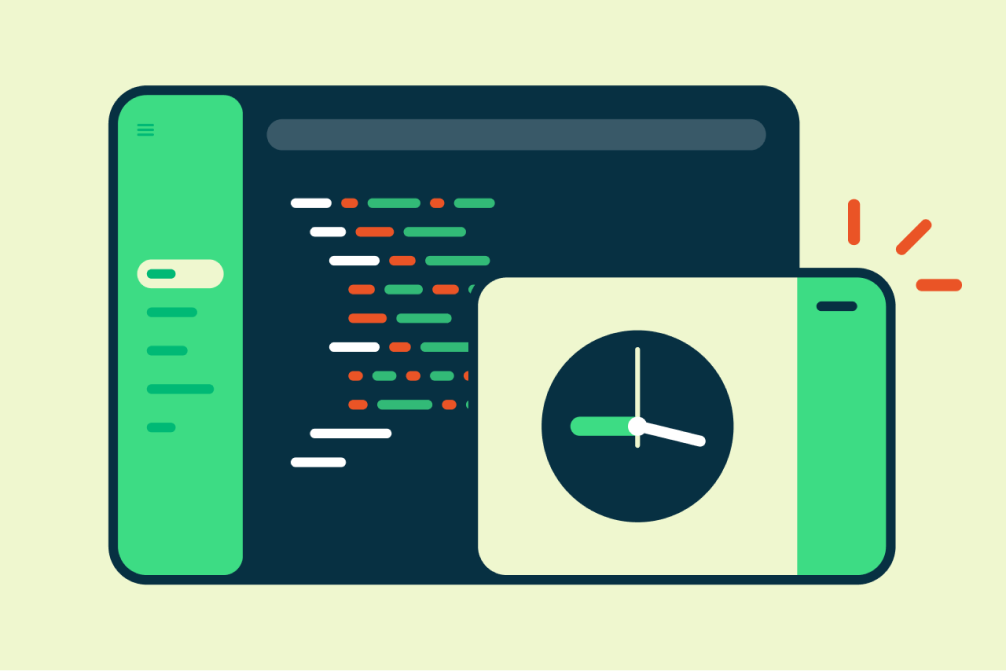หมายเหตุ: Watch Face Format เป็นข้อกำหนด สำหรับหน้าปัดที่จะติดตั้งในอุปกรณ์ที่ใช้ Wear OS 5 ขึ้นไป ที่ติดตั้งไว้ล่วงหน้า และสำหรับหน้าปัดใหม่ทั้งหมดที่เผยแพร่ใน Google Play
ตั้งแต่เดือนมกราคม 2026 เป็นต้นไป หน้าปัดนาฬิกาจะต้องใช้ Watch Face Format เพื่อให้สามารถติดตั้งในอุปกรณ์ Wear OS ทุกรุ่นได้
ดูข้อมูลเพิ่มเติมเกี่ยวกับการเปลี่ยนแปลงที่ผู้ใช้มองเห็นได้ใน บทความในศูนย์ช่วยเหลือนี้

หน้าปัดเป็นสิ่งแรกที่ผู้ใช้เห็นเมื่อมองนาฬิกา จึงเป็นพื้นผิวของ Wear OS ที่ใช้บ่อยที่สุด ผู้ใช้ใช้หน้าปัด เพื่อปรับแต่งนาฬิกาให้เหมาะกับสไตล์ของตนเองและดูข้อมูลอย่างรวดเร็ว ได้ในพริบตา
ตัวเลือกสำหรับการสร้างหน้าปัด
Watch Face Format (WFF) ช่วยให้สร้างหน้าปัดได้ง่ายกว่าที่เคย Watch Face Format สร้างขึ้นโดยความร่วมมือกับ Samsung และเป็นรูปแบบ XML เชิงประกาศ เพื่อกำหนดค่าลักษณะที่ปรากฏและลักษณะการทำงานของหน้าปัด Watch Face Format ต่างจาก API หน้าปัดอื่นๆ ที่ APK ต้องมีโค้ดเพื่อแสดงผลหน้าปัด ตรงที่ต้องใช้เพียงทรัพยากรและคำสั่งแบบประกาศ แพลตฟอร์ม Wear OS จะจัดการตรรกะที่จำเป็นในการแสดงผลหน้าปัดนาฬิกา เพื่อให้คุณ มุ่งเน้นไปที่ไอเดียสร้างสรรค์แทนการเพิ่มประสิทธิภาพโค้ดหรือประสิทธิภาพแบตเตอรี่
หน้าปัดที่สร้างด้วยรูปแบบนี้ต้องการการดูแลรักษาและอัปเดตน้อยกว่า หน้าปัดที่สร้างโดยใช้ไลบรารี Jetpack Watch Face แบบเดิม เช่น คุณไม่จำเป็นต้องอัปเดตหน้าปัดเพื่อรับประโยชน์จากการปรับปรุงประสิทธิภาพ หรือการใช้แบตเตอรี่ หรือเพื่อรับการแก้ไขข้อบกล่าสุด
เรามีวิธีสร้างหน้าปัดหลายวิธี ดังนี้
- หากต้องการเครื่องมือสไตล์ WYSIWYG ที่ให้คุณออกแบบหน้าปัดได้โดยตรง ให้ใช้ Watch Face Studio ซึ่งเราสนับสนุนร่วมกับ Samsung
- หากคุณถนัดใช้ Figma ในฐานะนักออกแบบ หรือหากคุณต้องการเร่งขั้นตอนแรกๆ ในการสร้างหน้าปัดในฐานะนักพัฒนาแอป ให้ใช้ Watch Face Designer ซึ่งคุณเข้าถึงได้โดยใช้ปลั๊กอินภายใน Figma
หากต้องการจัดการการกำหนดค่านาฬิกาด้วยตนเองและเผยแพร่ไปยัง App Store ของคุณเอง คุณสามารถกำหนดหน้าปัดโดยใช้ XML ได้ Android Studio มีการรองรับการสร้างหน้าปัดที่ใช้ Watch Face Format จากนั้นคุณจะเห็นภาพหน้าปัดเหล่านี้ได้โดยการเรียกใช้ในอุปกรณ์
หลังจากสร้างหน้าปัดแล้ว คุณจะเผยแพร่ได้หลายวิธี เช่น ผ่าน Google Play หรือใช้ Watch Face Push
เกี่ยวกับรูปแบบ
หัวใจสำคัญของหน้าปัด Watch Face Format (WFF) คือเอกสารที่กำหนด เลย์เอาต์และลักษณะการทำงานของหน้าปัด เอกสารนี้เขียนในรูปแบบ XML ตามข้อกำหนด WFF
ระบบ Wear OS มีคอมโพเนนต์ตัวแสดงผลหน้าปัด คอมโพเนนต์นี้ จะแยกวิเคราะห์เอกสาร XML ของ WFF และแสดงผลหน้าปัดจากเอกสารดังกล่าว ระบบจะดึงทรัพยากรอื่นๆ เช่น รูปภาพและแบบอักษร เข้ามาตามความจำเป็น
แนวทางนี้หมายความว่าคุณเพียงแค่ต้องใช้เวลาอธิบายว่าหน้าปัดควรมีลักษณะอย่างไร และ Wear OS จะจัดการโค้ดทั้งหมดสำหรับการวาดหน้าปัด
หากต้องการติดตั้งใช้งานหน้าปัด Watch Face Format ในอุปกรณ์ ให้แพ็กเกจเอกสาร XML ในแพ็กเกจ AAB หรือ APK มาตรฐาน
แผนภาพต่อไปนี้แสดงภาพรวมของแนวทาง

การกำหนดเวอร์ชันใน WFF
เมื่อ WFF พัฒนาขึ้น ระบบจะเพิ่มฟีเจอร์เพิ่มเติมซึ่งแสดงด้วยองค์ประกอบ แอตทริบิวต์ และแหล่งข้อมูลที่มากขึ้น ซึ่งทั้งหมดใช้รูปแบบหน้าปัดนาฬิกา
เช่น WFF เวอร์ชัน 2 ได้เปิดตัวการรองรับสภาพอากาศเป็นแหล่งข้อมูล ซึ่ง ไม่มีใน WFF เวอร์ชัน 1
เมื่อออกแบบหน้าปัดนาฬิกา โปรดทราบว่าคุณต้องการใช้ฟีเจอร์ใดและฟีเจอร์นั้นพร้อมใช้งานในเวอร์ชันใด คู่มืออ้างอิงจะทำเครื่องหมาย ฟีเจอร์ทั้งหมดพร้อมความพร้อมใช้งาน
WFF แต่ละเวอร์ชันจะสอดคล้องกับการเปิดตัว Wear OS ดังนี้
| เวอร์ชัน WFF | เวอร์ชัน Wear OS ขั้นต่ำ | ระดับ API ขั้นต่ำ |
|---|---|---|
| 1 | 4 | 33 |
| 2 | 5 | 34 |
| 3 | 5.1 | 35 |
| 4 | 6 | 36 |
ดูคำแนะนำนี้เพื่อกำหนดค่า AndroidManifest.xml และไฟล์บิลด์ Gradle
อย่างเหมาะสม
ดูข้อมูลเพิ่มเติม
ดูข้อมูลเพิ่มเติมเกี่ยวกับ Watch Face Format ได้ในคำแนะนำต่อไปนี้
- ฟีเจอร์ที่ใช้ได้: สำรวจความสามารถของหน้าปัดที่ Watch Face Format แต่ละเวอร์ชันรองรับ
- หลักเกณฑ์การออกแบบ: ดูแนวทางปฏิบัติแนะนำสำหรับเลย์เอาต์และประสบการณ์ของผู้ใช้ของหน้าปัด
- Watch Face Designer: ดูวิธีใช้ปลั๊กอิน Figma เพื่อสร้างหน้าปัดนาฬิกา
- การตั้งค่า: กำหนดค่า Android App Bundle ที่รองรับรูปแบบหน้าปัดนาฬิกา
- ตัวอย่าง GitHub: เริ่มต้นใช้งานโดยสร้างหน้าปัดนาฬิกาตัวอย่าง และติดตั้งใช้งานในโปรแกรมจำลอง Wear OS หรืออุปกรณ์จริง
- เพิ่มประสิทธิภาพการใช้หน่วยความจำ: ดูวิธีกำหนดค่าหน้าปัดเพื่อให้ระบบใช้หน่วยความจำน้อยที่สุดเท่าที่จะเป็นไปได้เมื่อแสดงผลหน้าปัด
- ข้อมูลอ้างอิง XML: สำรวจองค์ประกอบแต่ละรายการที่เป็นส่วนหนึ่งของ
ไฟล์ Watch Face Format องค์ประกอบรูทคือ
WatchFaceเสมอ หมายเหตุ: หากต้องการดูฟีเจอร์จาก Watch Face Format เวอร์ชันใดเวอร์ชันหนึ่งในข้อมูลอ้างอิง XML ให้ตรวจสอบว่าได้เลือกปุ่มเวอร์ชันที่เหมาะสมที่ด้านบน ของหน้าเอกสารประกอบ - คู่มือการเผยแพร่: ดูวิธีเผยแพร่และสร้างรายได้จาก หน้าปัดผ่าน Play Store และวิธีอื่นๆ
- เครื่องมือตรวจสอบ WFF และหน่วยความจำ: ใช้เครื่องมือโอเพนซอร์สเหล่านี้เพื่อ ตรวจสอบข้อผิดพลาดในไฟล์รูปแบบหน้าปัดนาฬิกาและยืนยันการใช้หน่วยความจำที่ยอมรับได้ ก่อนส่งไปยัง Google Play

